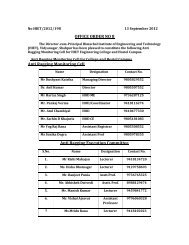Download Syllabus of Mechanical Engineeing. - HIET
Download Syllabus of Mechanical Engineeing. - HIET
Download Syllabus of Mechanical Engineeing. - HIET
Create successful ePaper yourself
Turn your PDF publications into a flip-book with our unique Google optimized e-Paper software.
1. Kothari & Nagarath: Basic Electrical Engg. (2 nd Edition), TMH.<br />
2. B.L. Theraja & A.K. Theraja, S.Chand: Electrical Technology(Vol-1).<br />
Deltoro: Electrical Engg Fundamentals, PHI.<br />
BASIC MECHANICAL ENGINEERING( ME – 1003)<br />
Course Code ME - 1003 Credits: 4 L-4, T-1, P-0<br />
Name <strong>of</strong> the Course Basic <strong>Mechanical</strong> Engineering<br />
Lectures to be delivered 52 (1 Hr Each) (L = 39, T = 13 for each semester)<br />
Semester End Examination Maximum Time: 3 hrs. Max. Marks: 100 Min. Pass Marks: 40<br />
Continuous Assessment (based on sessional tests (2) 50%,<br />
Tutorials/Assignments 30%,<br />
Quiz/Seminar 10%, Attendance 10%)<br />
Instructions<br />
Max. Marks: 50<br />
1. For Paper Setters: The question paper will consist <strong>of</strong> five sections A, B, C, D & E. Section E will be<br />
compulsory, it will consist <strong>of</strong> a single question with 10-20 subparts <strong>of</strong> short answer type, which will cover<br />
the entire syllabus and will carry 20% <strong>of</strong> the total marks <strong>of</strong> the semester end examination for the course.<br />
Section A, B, C & D will have two questions from the respective sections <strong>of</strong> the syllabus and each<br />
question will carry 20% <strong>of</strong> the total marks <strong>of</strong> the semester end examination for the course.<br />
2. For candidates: Candidates are required to attempt five questions in all selecting one question from each<br />
<strong>of</strong> the sections A, B, C & D <strong>of</strong> the question paper and all the subparts <strong>of</strong> the questions in Section E. Use <strong>of</strong><br />
non-programmable calculators is allowed.<br />
SECTION – A<br />
First Law <strong>of</strong> Thermodynamics<br />
Essence and corollaries <strong>of</strong> the first law, analytical expressions applicable to a process and cycle, internal energy,<br />
enthalpy and specific heats, first law analysis <strong>of</strong> steady flow, applications <strong>of</strong> steady flow energy equation to<br />
engineering devices.<br />
Applications <strong>of</strong> first law <strong>of</strong> Thermodynamics<br />
Closed and open systems, analysis <strong>of</strong> non-flow and flow processes for an ideal gas under constant volume<br />
(Isochoric), constant pressure (Isobaric), constant temperature (Isothermal), adiabatic and polytropic conditions.<br />
Analysis <strong>of</strong> free expansion and throttling processes. Representation <strong>of</strong> these processes on P-V charts and analysis<br />
<strong>of</strong> property changes and energy exchange (work and heat) during these processes.<br />
SECTION – B<br />
Second Law <strong>of</strong> Thermodynamics<br />
Limitations <strong>of</strong> first law, various statements <strong>of</strong> second law and their equivalence, application <strong>of</strong> statements <strong>of</strong> second<br />
law to heat engine, heat pump and refrigerator. Philosophy <strong>of</strong> Carnot cycle and its consequences. Carnot theorem<br />
for heat engines and heat pump. Classius inequality, concept and philosophy <strong>of</strong> entropy and entropy changes<br />
during various processes. Temperature – entropy chart and representation <strong>of</strong> various processes on it. Third law <strong>of</strong><br />
thermodynamics.<br />
SECTION – C<br />
Simple Stresses & Strains<br />
Concept & types <strong>of</strong> Stresses and strains, Poisson’s ratio, stresses and strain in simple and compound bars under<br />
axial loading, stress strain diagrams, Hooks law, Elastic constants and their relationships. Temperature stress and<br />
strain in simple and compound bars under axial loading, Numerical problems.<br />
Shear Force and Bending Moments<br />
Definitions, SF & BM diagrams for cantilevers, simply supported beams with or without over-hang and calculation <strong>of</strong><br />
maximum BM and SF and the point <strong>of</strong> contraflexture under (i) concentrated loads, (ii) uniformly distributed loads<br />
over whole span or a part <strong>of</strong> it, (iii) combination <strong>of</strong> concentrated loads and uniformly distributed loads. Relation<br />
between the rate <strong>of</strong> loading, the shear force and the bending moments, Numerical Problems.<br />
SECTION – D<br />
Bending Stresses in Beams<br />
Bending Stresses in Beams with derivation <strong>of</strong> Bending equation and its application to beams <strong>of</strong> circular, rectangular<br />
I & T Section, Composite beams,<br />
Torsion <strong>of</strong> Circular Members<br />
Torsion <strong>of</strong> Solid and hollow circular shafts, Combined bending and torsion, Equivalent torque, Numerical Problems.<br />
Text Books<br />
1. Nag, P.K., “Engineering Thermodynamics”, Tata McGraw – Hill, New Delhi.<br />
2. Yadav, R., Thermal Science and Engineering, Central Publishing House, Allahabad.<br />
3. Strength <strong>of</strong> Materials – G.H.Ryder – Third Edition in S I units 1969 Macmillan India.<br />
4. Mechanics <strong>of</strong> Materials – Dr. Kirpal Singh, Standard Publishers Distributors, New Delhi.<br />
Reference Books<br />
1. Strength <strong>of</strong> Materials – Popoy, PHI, New Delhi.<br />
2. Strength <strong>of</strong> Materials – Sadhu Singh, Khanna Publications.<br />
3. Strength <strong>of</strong> Materials – A Rudimentary Approach – M.A.Jayaram, Revised Ed. 2001, Sapna Book House,<br />
Bangalore.<br />
28



